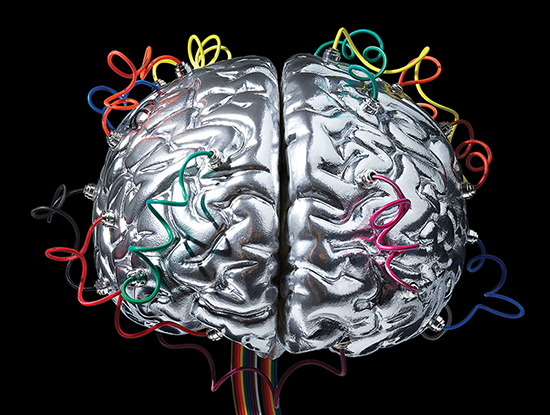人工智能风头不减:几个术语帮你迅速了解

|
人工智能大火,商界领袖人人都在谈。新科技产品绕不开人工智能,头条新闻也不断记录着相关讨论。但对许多人来说,人工智能仍然是个谜。 为了帮助人们迅速了解,我们制作了一份指南解释相关术语。简单来说,人工智能处理的数据越多,就会越完善,对企业来说用处越大。 强化学习 这种人工智能技术类似于用食物训练狗。软件成功执行任务后即可学习经验,失败后也可以吸取教训。强化学习和深度学习的融合带来了巨大突破,比如说计算机已经在复杂的电子游戏和棋盘游戏中击败人类玩家。范例:Facebook的定向通知功能。 神经网络 人工智能的兴起可以追溯至数十年以前,当时开发的软件主要模拟人脑学习过程。神经网络内部是多层互联节点用于计算,可以帮助计算机精确筛选数据,软件也能从中学会识别最聪明的人类也可能忽略的模式。范例:百度搜索。 深度学习 结合神经网络和机器学习就可以实现深度学习,这是一种强大的技术,可以处理海量音频文件档案等庞大的数据。人工智能最大的一些突破都是由此实现,比如在照片中识别雪豹等。范例:英伟达3D人工智能生成的人脸。 机器学习 老板发邮件问一份重要文件是否已经准备妥当,系统建议回复(“看起来没问题”),又或者老板问中午能不能见面,系统建议回复(“到时见!”),这些都要感谢机器学习。这些对于算法帮计算机“学习”还是能算管中窥豹。该技术的最吸引人之处在于:企业无需耗费人力为处理每项具体任务编写程序。范例:谷歌Gmail。 计算机视觉 计算机视觉设备几乎能够像人类一样看到并理解周边环境。比如可以自动解锁iPhone的面部识别技术,或是能够帮助自动驾驶汽车导航而不会撞到树上的系统。这个问题看上去很容易解决,但实际上非常困难。范例:Waymo自动驾驶汽车。 自然语言处理 这种技术可以让计算机理解人类对话和语言并作出回应。语音控制数字助理就是该技术的应用,可以接受语音指令,或是为联网家用音箱提供支持。相关技术仍未完善,但进步很快。范例:Amazon Alexa数字助理服务。(财富中文网) 本文另一版本登载于《财富》杂志2019年6月刊,标题为《人工智能101》。 译者:Charlie 审校:夏林 |
Artificial intelligence is having its moment. Business leaders can’t stop talking about it. New tech products invariably include it. And news headlines incessantly chronicle the buzz around it. But for many people, artificial intelligence remains a mystery. To help, we’ve created a guide that explains some of the key terms associated with the technology, an increasingly useful tool for businesses that improves as it crunches more data. Reinforcement Learning This A.I. technique is like training a dog with treats. The software learns by successfully executing a task and, on the flip side, from failure. This fusion of reinforcement learning with deep learning has led to tremendous breakthroughs, like computers beating humans at complicated video and board games. Example: Facebook’s targeted notifications. Neural Networks A.I.’s rise can be traced to software developed decades ago that was intended to approximate how the human brain learns. Inside a neural network are layers of interconnected nodes where calculations take place that help computers sift though data in minute detail. By doing so, the software can learn to recognize patterns that even the most intelligent humans may overlook. Example: Baidu search. Deep Learning Mixing neural networks with machine learning makes for deep learning, a powerful technology that can crunch enormous amounts of data, like vast archives of audio clips. A.I.’s biggest breakthroughs—such as recognizing snow leopards in photos—can be traced to the technology. Example: Nvidia’s 3D A.I.-generated faces. Machine Learning You can thank machine learning for recommending how to respond to your boss when she emails asking whether an important document is in order (“Looks good to me”) or whether you can meet at noon (“Let’s do it!”). This is just a taste of how algorithms help computers “learn.” The chief attraction: Companies don’t need humans to program the technology for each specific task it handles. Example: Google Gmail. Computer Vision Devices using computer vision are able to see and understand their surroundings almost like a human. Think of facial-recognition technology that can automatically unlock your iPhone or the systems that help navigate self-driving cars without crashing them into trees. The problem seems easy to solve. But in reality, it’s very difficult. Example: Waymo’s autonomous vehicles. Natural Language Processing This technology makes it possible for computers to understand and react to human speech and language. Voice-controlled digital assistants, which take dictation or power Internet- connected home speakers, would be impossible without it. The technology is still imperfect, but it’s improving quickly. Example: Amazon Alexa digital assistant. A version of this article appears in the June 2019 issue of Fortune with the headline “Artificial Intelligence 101.” |













